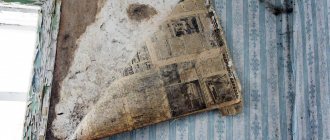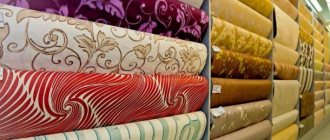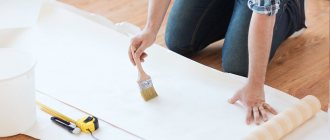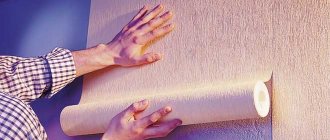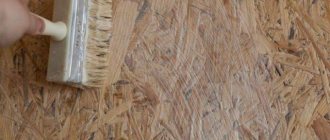Where to begin?
- First of all, clean the surface you need from the old finish: remove old wallpaper, decorative plaster, paint. Remove all nails, bolts and sockets.
- It is best to smooth out microcracks, “sinks”, and peelings with putty and sand the surface with sandpaper. This must also be done if there are differences of more than 10 mm per 2 m.
- Prime the walls with penetrating acrylic primer. It will reduce the moisture capacity of the base and strengthen it. Carry out the work in 2 steps, taking a break of 3-4 hours between stages. Acrylic primer can be replaced with wallpaper glue diluted to a liquid state.
- Apply markings for convenience: one vertical line - at a distance of 1 meter from the corner, from the starting line - segments equal to the width of the roll, and vertical strokes for joining the wallpaper.
Advice
Reference! To remove old paint, use a medium-grained abrasive and remove dust with a special product.
The list of tools required for work includes:
- Laser level (plumb line).
- 3 meter tape measure.
- Wide metal spatula.
- Knife.
- Ditches for glue.
- Rollers (rubber - for rolling out wallpaper, with pile - for applying glue).
- A bucket for water, a foam sponge, a simple pencil, a clean towel.
Pasting stages
To understand how to properly glue paper wallpaper onto wallpaper, you need to refer to the step-by-step instructions:
- At the first stage, it is better to prime the surface. You can use glue, which will then be used for the main stage. The only difference is that it should be more liquid, and application is done using a roller in one layer.
- At this time, the canvases are prepared. One standard roll is divided into 3. If there is a pattern, trimming is done in such a way that the pattern matches each other. This is a very important process that must be taken seriously.
- Glue preparation. You must follow the recommendations on the packaging. After this, a uniform application is made on the wall or canvas (if paper wallpaper is used).
- From the next stage, the whole process is exactly the same as in the usual version of pasting. You should start from the corner, all the canvases are laid from the ceiling. After they are glued to the wall, they are leveled with a rubber spatula. The second canvas is glued exactly at the joint when using non-woven or vinyl options, or overlapping if paper materials are used.
How to paste in corners
The first thing to do is to trim the canvas with an allowance of 5-6 centimeters, and it is not treated with glue. The second canvas on the other wall is laid in exactly the same way. An incision is made on two canvases from the ceiling to the floor and all allowances are removed from them, and each of the joints is treated with glue.
Wall cleaning
How to put wallpaper on old wallpaper and when it can be done - we figured it out. How can you prepare the walls with your own hands in all other cases? Is it difficult to remove decorative coating?
Paper and non-woven fabric
Both materials are not waterproof and, more importantly, are permeable to moisture. The adhesives used for them are also not resistant to moisture.
The conclusion is obvious: just wet the wallpaper generously and it will come off the base.
- We moisten the surface of the walls using a sprayer, a rag, a wide brush or a long-haired roller. Don’t forget to turn off the power to the sockets first: water rich in mineral salts is an excellent conductor.
- Repeat the treatment after 10-15 minutes.
- We remove the coating in whole strips, prying the edges with a spatula. They also clean up the inevitable flaws.
Soaked paper will easily come off the wall.
Vinyl
What to do with waterproof vinyl?
There are two options.
- Vinyl film is strong enough to pull away from the wall with enough force without tearing. The wallpaper backing remaining on the base can, depending on its condition, be used as a base for a new coating or be removed after dampening.
- Plan B is to soak the backing directly under the vinyl layer. To do this, just roll it with a needle roller or simply scratch the surface with a sharp knife. Further operations are no different from the case of paper and non-woven fabric.
The needle roller will break the seal of the vinyl film.
How to choose?
Since there are many varieties of vinyl wallpaper, when choosing, you need to decide what room it will be intended for and what needs it should satisfy. What kind of surface do you want to get?
If you need a moisture-resistant wall covering intended for the bathroom or kitchen, look at the characteristics of the wallpaper on the packaging and choose one with cleaning properties.
Texture and pattern may be perfect for some spaces but completely inappropriate for others. Vinyl wallpaper can look like a brick wall, imitate Venetian plaster or leather.
The same can be said about the color of the wallpaper: the choice of shades of the color palette is quite wide. This coating makes the walls look voluminous and allows you to play with light. Therefore, consider the size and lighting of the room.
It is also important to consider the possibility of mechanical damage. If there are a lot of people in the room, there are small children or pets, you should choose a denser and more durable coating option.
Undoubtedly, vinyl wallpaper is an excellent choice for those who value environmental friendliness, considerable service life of the coating, high quality and beauty.
Technology
So, we found out that the new finishing material can be glued over thin single-layer paper. Let's move on to a specific example.
How to glue non-woven wallpaper onto old wallpaper left over from the previous owners of the apartment? Neither the composition of the wallpaper glue nor the type of base underneath is known to us for certain.
Let's start with an experiment.
We apply an acrylic-based penetrating primer to a small section of the wall and observe the development of events.
If the coating comes off or bulges, it will have to be removed.
As a rule, the result of the experiment is disappointing.
If the surface remains smooth after drying, you can dance the rumba and proceed to further operations.
- Vacuum the surface . If somewhere the walls are oily, degrease them with acetone.
- Prime with penetrating primer twice . The task is to saturate both the paper and the base underneath it as much as possible with the primer, tying them into a single whole. When dried, the water base of the primer evaporates, and the polymer binder in its composition forms thin and strong threads that lead deep into the wall and strengthen its surface layer.
In addition: the primer will significantly improve the adhesion of the walls to the glue.
- We sand the inevitable unevenness and a few swellings . It is better to use a mesh rather than sandpaper: it becomes clogged with paper and plaster more slowly.
The surface is ready. How to paste wallpaper on old wallpaper in our case?
Further operations are quite normal for non-woven fabric: glue is applied to the wall surface, after which the canvas is aligned vertically and glued. The following strips are glued end to end.
A caveat: for heavy materials (non-woven fabric and vinyl), it is better to use special adhesives. Their price is slightly higher than that of paper glue; for the difference in cost, the buyer receives a composition with increased viscosity and better adhesive properties.
The photo shows adhesive for vinyl coverings.
How to glue corners with vinyl wallpaper
When gluing wallpaper, some people are faced with the problem of how to stick it in the corner. Option 2 – overlapping and undercut. The overlapping option requires the preparation of a special glue intended for processing the edge of the wallpaper.
Instructions:
- First, one strip is glued.
- Then the strip is laid on the other side of the corner.
- One of the strips should overlap the other in the corner.
In order for their connection to be strong, at the moment of gluing the canvas one to the other, it is necessary to pass it in the corner part with a brush dipped in the adhesive composition. Thus, when drying, there will be practically no visible gap or corner part of the room. In most cases, when working with vinyl, experts prefer to install special decorative plaster overlays in the corners of the room, which perfectly mask defects such as overlaps, because vinyl is a dense material, and it can bulge a little.
After the second sheet is glued, the same overlap occurs, which needs to be cut along and through both sheets.
It is advisable to use a level and a metal ruler. Scraps of canvas must be removed, and care must be taken to ensure that the material does not swell and that there is no excess glue, which will not be as easy to remove after complete drying as in liquid form.
Let's start gluing
The photo shows a set of tools for a professional upholsterer
Before we start work, we stock up on all the necessary tools.
We will need:
- container for preparing glue;
- a paint tray for dipping the roller into glue;
- velor roller and thick roller for rolling out glued wallpaper;
- flat brush for coating hard-to-reach places;
- a professional wallpaper brush or, alternatively, a soft cloth;
- sharp mounting knife;
- wide spatula;
- measuring instrument, including tape measure, ruler and pencil;
- durable, stable stepladder;
- a clean surface, such as a table.
Apply wallpaper with glue only on a flat and clean surface.
The work instructions are as follows:
- We prepare the glue in accordance with the manufacturer's instructions , but at the same time add PVA to the base composition and mix the solution until it has a homogeneous consistency.
- We measure the height of the walls and cut pieces of wallpaper.
- Apply glue to the wall and the back side of the canvas , regardless of its composition, and wait for 5-10 minutes.
- Then we apply the piece to the wall and evenly iron the coating over the entire surface so that all the glue is dispersed and there are no air pockets left.
- The following pieces are applied end-to-end , so it is so important to immediately remove the protruding glue.
- At the baseboard and baguette we cut off the excess wallpaper using a spatula.
New wallpaper on vinyl flooring: is it possible or not?
You cannot attach new wallpaper directly to vinyl sheets. Regardless of the type of adhesive you choose, most likely it will simply not work, since the synthetic coating has water-repellent properties. This is especially true for washable wallpaper. Additionally, most vinyl materials have a textured pattern that will show through a fresh coat of finish.
However, there is still a chance to avoid complete elimination of such coverage. If, after removing the vinyl wallpaper, it was possible to remove the top polyvinyl chloride film, and the remaining paper or non-woven layer does not want to come off and adheres firmly to the wall, you can also glue a new sheet onto it.
USEFUL INFORMATION: How to properly glue non-woven wallpaper
Recommendations and tips
- Before purchasing finishing material, calculate how many rolls you need in order to immediately take the required number of tubes for one change of release and article number. This will help avoid color mismatches in different wallpaper rolls. First, determine the area of the walls (multiply the height by the length and sum up all the results), subtract the area of window and door openings, divide by the area of one roll.
- Choose the right glue. It must be diluted to the desired (thick) consistency so that it is applied in a thin layer and does not leak, has good adhesion to the trellises and does not leave yellow marks after drying. All these requirements are met by specialized glue (for heavy and light wallpaper). It is better to use a universal one only as a last resort - it does not hold the wallpaper well.
Popular brands:- "The Interlining Moment."
"Methylane Interlining ultra premium."
- "Quelyd Special non-woven fabric".
- "FliziLex", "Exclusive Non-Woven".
- "Kleo Non-woven".
The number of packs is calculated as follows: the wall area is divided by the consumption in square meters indicated on the packaging and the result is rounded.
Pour the required amount of warm water into the basin and, stirring the water until a funnel appears, pour the glue into its center. You can do this with your hand or a stick; a drill with an attachment (mixer) is used later to break up all the small lumps. Afterwards, the glue is allowed to swell (15 minutes) and used. Within half an hour after starting kneading, you can add another 200 ml of water.
Hanging wallpaper with your own hands is not that difficult. The main thing: take careful measurements, calculate proportions, buy high-quality materials and approach the matter with all the attention. Then your work will not be in vain.
